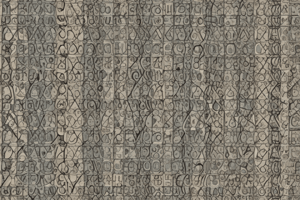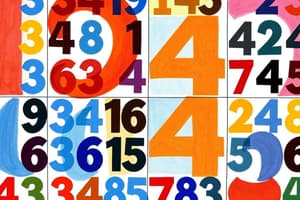Podcast
Questions and Answers
What is the missing number in the series 55, 107, 317, ?, 6309, 37847?
What is the missing number in the series 55, 107, 317, ?, 6309, 37847?
- 6312
- 1428 (correct)
- 1263
- 1514
Identify the next term in the series 2, 10, 30, 68, ?
Identify the next term in the series 2, 10, 30, 68, ?
- 130 (correct)
- 120
- 125
- 124
Which number fits the sequence 1, 2, 3, 6, 9, 18, ?, 54?
Which number fits the sequence 1, 2, 3, 6, 9, 18, ?, 54?
- 81
- 18
- 27 (correct)
- 36
Find the wrong term in the series 2, 6, 18, 32, 50, 72, 98.
Find the wrong term in the series 2, 6, 18, 32, 50, 72, 98.
What is the missing number in the series 20 : 7980 :: 12 : ?
What is the missing number in the series 20 : 7980 :: 12 : ?
What number comes next in the series: 4, 5, 7, 10, 14, ?
What number comes next in the series: 4, 5, 7, 10, 14, ?
What is the next number in the series: 4, 7, 10, 13, 16, 19, ?
What is the next number in the series: 4, 7, 10, 13, 16, 19, ?
What number follows in the series: 4, 5, 8, 13, 20, 29, ?
What number follows in the series: 4, 5, 8, 13, 20, 29, ?
Determine the next number in the series: 4, 6, 10, 16, 24, 34, ?
Determine the next number in the series: 4, 6, 10, 16, 24, 34, ?
What comes next in the series: 170, 149, 130, 113, ?
What comes next in the series: 170, 149, 130, 113, ?
What is the next number in the series: 325, 259, 204, 160, 127, ?
What is the next number in the series: 325, 259, 204, 160, 127, ?
What comes next in the series: 4, 2, 2, 3, 6, ?
What comes next in the series: 4, 2, 2, 3, 6, ?
What follows in the series: 12, 13, 15, 17, 21, 23, 27, 29, 33, ?
What follows in the series: 12, 13, 15, 17, 21, 23, 27, 29, 33, ?
Flashcards
Number Series
Number Series
A sequence of numbers that follows a specific pattern or rule.
Arithmetic Pattern
Arithmetic Pattern
Adding or subtracting the same value between consecutive numbers.
Geometric Pattern
Geometric Pattern
Multiplying or dividing by the same value between consecutive numbers.
Look for Differences
Look for Differences
Signup and view all the flashcards
Alternating Patterns
Alternating Patterns
Signup and view all the flashcards
Complex Patterns
Complex Patterns
Signup and view all the flashcards
Squaring the Previous Term
Squaring the Previous Term
Signup and view all the flashcards
Multiples
Multiples
Signup and view all the flashcards
Ratio and Proportion
Ratio and Proportion
Signup and view all the flashcards
Pattern of Differences
Pattern of Differences
Signup and view all the flashcards
Adding Even Numbers
Adding Even Numbers
Signup and view all the flashcards
Addition of Multiples
Addition of Multiples
Signup and view all the flashcards
Study Notes
Number Series
- Number series questions present a sequence of numbers and ask for the next number in the series.
- Identifying the pattern is key to solving these questions.
- Patterns can be arithmetic (addition/subtraction), geometric (multiplication/division), or a combination of both.
- Example: In the series 4, 7, 10, 13, 16, 19, the pattern is adding 3 to each subsequent number. Therefore, the next number is 22.
- Understanding the pattern allows you to predict the next number in the series.
Tips for Solving Number Series
- Look for differences between consecutive numbers.
- Identify the sequence's starting point.
- Test for arithmetic or geometric progressions.
- Consider alternating patterns (e.g., adding and subtracting)
- Examine square, cube, or factorials for more complex patterns.
Practice Problems and Solutions:
- Problem 1: 4, 5, 7, 10, 14, ?
- Pattern: The difference between consecutive numbers increases by 1 (2, 3, 4, 5).
- Solution: The next number is 21.
- Problem 2: 4, 6, 10, 16, 24, 34, ?
- Pattern: The difference between consecutive numbers increases by 2 (4, 6, 8, 10, 12).
- Solution: The next number is 46.
- Problem 3: 103, 88, 101, 90, 99, 92, 97, 94, ?, ?
- Pattern: The series alternates between subtracting 15 and adding 13.
- Solution: The next numbers are 96, 95.
- Problem 4: 2, 5, 26, ?
- Pattern: The sequence is based on squaring the previous term and adding one and then multiplying by 2 (2^2 + 1 = 5. 5^2 + 1 = 26.
- Solution: The next term is 677.
- Problem 5: 1, 2, 3, 6, 9, 18, -, 54
- Pattern: The sequence involves multiplying by 2 and then 3.
- Solution: The next term is 27.
- Problem 6: 0, 10, 24, 68, 120, ?
- Pattern: The differences between consecutive numbers follow a pattern. 10, 14, 44, 52.
- Solution: The next term is 210.
- Problem 7: 20:7980::12:?
- Pattern: 20^2 + 20 x 19 = 7980.
- Solution: 1716
- Problem 8: 2, 5, 10, 50, 500, ?
- Pattern: Multiply the previous term by 2.5, then by 10, and then by 10
- Solution: The next term is 50,000.
- Problem 9: 5, 13, 31, 69, 147, ?
- Pattern: The pattern here is the difference between each term and the next term increases by 8 (8, 18, 38, 78); then, the next term is 305 and the differences between each term and the next term increase by 8 each time (8 18 38 78 158)
- Solution: The next term is 305.
- Problem 10: 2, 4, 6, 12, 22, ?
- Pattern: Starting with 2, add consecutive even numbers to the previous term (2 + 2 = 4, 4 + 2 = 6, 6 + 6 = 12, 12 + 10 = 22)
- Solution: The next term is 42.
- Problem 11: 4, 10, 22, 46, ?, 190
- Pattern: Add consecutive multiples of 6 (4 10 22 46 94 190)
- Solution: The next term is 94.
Studying That Suits You
Use AI to generate personalized quizzes and flashcards to suit your learning preferences.




